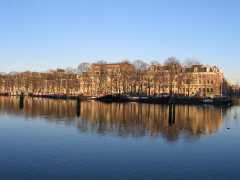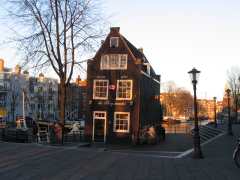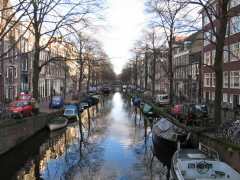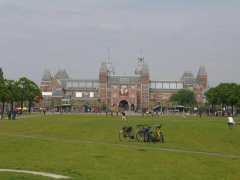
Amsterdam is a particularly popular city for travellers, not least for its thriving nightlife and beautiful historic centre. But along with the throngs of visitors come high prices, and if not adequately prepared, the unsuspecting traveller can find themselves spending considerably more money than they had intended to.
With a bit of planning, however, it’s possible spend time in Amsterdam without blowing a fortune – or, at the very least, being able to save your money during the day so that you can party hard at night, if that takes your fancy. This guide tells you how.
Transport – Rail
If you’re planning on taking a train to Amsterdam, there’s three main international routes; from the south, via Antwerp (from Brussels), from the east (Berlin or Hamburg, via Osnabrueck) or from the south-east (via Cologne and Duesseldorf).
The southern route is serviced by two express services; the more expensive Thalys trains and the cheaper Intercity (IC) service, provided as a joint service by the Dutch rail operator NS and the Belgian rail operator NMBS/SNCB. As the high-speed rail lines through the Netherlands have not yet been completed, taking the Thalys service will only save you twenty minutes.
From Berlin, there is only one direct option; the IC trains via Osnabrueck. This service isn’t frequent, and one of the services each day stops at Amsterdam-Zuid (Amsterdam south) rather than the main Amsterdam Centraal station. If these trains don’t run at a time suitable for you, then the only other option is to take slower, regional services via Muenster and Enschede; this will involve multiple connections, and is unlikely to save you any money.
If you’re travelling via Cologne, the main service to Amsterdam is provided by the German Deutsche Bahn Intercity Express (ICE) trains. These trains normally incur a surcharge, but are the only direct route – if you’re happy to spend four hours on trains, rather than two and a half, there is the option of taking Regional Express (RE) and IC trains, changing at Mönchengladbach, Venlo and Eindhoven, which could save you €11.
Be aware, when purchasing tickets to leave Amsterdam, that there are surcharges for over-the-counter tickets to Belgium and Germany; where possibly, purchase from the electronic vending machines located in the railway stations.
Transport – Bus
For those who are extremely budget conscious, international buses provide possibly the cheapest journey to Amsterdam. Most services are provided by Eurolines, and arrive and depart at Amsterdam’s Amstel station, which means you’ll need to use the metro to get to the city centre from there.
If your trip to Amsterdam is part of a larger European trip, the Busabout Northern Loop service, provides an alternative to Eurolines.
Transport – Air
Budget flights in Europe have been booming for years, but be aware that not all airlines quote taxes in their fares, some have surcharges if you have anything more than just hand luggage and often they don’t fly to major airports. Ryanair‘s only Dutch destination, for example, is Eindhoven airport; getting to Amsterdam from there would involve an 80 minute train trip, at a cost of €17, one way.

That said, there certainly are some cheap deals to be had, if you book in advance. A quick check at Easyjet’s website turned up flights to Amsterdam Schiphol airport for £29, one way, for just a week in advance.
At the time of writing, Jet2 was offering £0.99 fares from Leeds to Schiphol, but of course, there were taxes of £14.98 on top of this.
Amsterdam Schiphol airport is very served by trains, accessible from the railway station underneath it. They’re fast, frequent and considerably less expensive than a taxi. For an even cheaper, albeit less-comfortable trip, there are the Schiphol Sternet buses.
Transport – getting around Amsterdam
The centre of Amsterdam is quite compact; if you’re in town to party, indulge in alcohol and other hedonistic pleasures, then you’ll be able to just stagger from bar to bar – provided you can stand up. However, a day on your feet can really knock you out and it’s advisable to make use of Amsterdams extensive and frequent trams, buses and metro – it’s much, much cheaper than a taxi.
For occasional trips, you can make do with a strip-card ticket (“strippenkaart”), which are available from vending machines in supermarkets and railway stations. If you plan to make a lot of use of public transport, then 1, 2, 3 and 4-day tickets can be purchased from the service outlet of the Amsterdam public transport corporation GVB, which is located directly opposite Centraal Station, on the south side.
Accomodation
Amsterdam has a number of youth and backpacker hostels, which will be the cheapest accomodation available, short of finding a private room.
The Dutch branch of the Hostelling International organisation is Stayokay. There are two Stayokay hostels in Amsterdam, with a third opening in July 2007:
- Stayokay Amsterdam Stadsdoelen, located close to the red-light district.
- Stayokay Amsterdam Vondelpark, in Amsterdam’s inner south-west.
- Stayokay Amsterdam Zeeburg (opens July 2007), in Amsterdam’s east.
Of the three, the Stadsdoelen hostel is the easiest to get to and cheapest to stay at, but it has considerably fewer beds than the Vondelpark hostel, so in summer it would be best to book ahead – or, at the very least, try to arrive early in the day.
The Flying Pig are two well-known and popular hostels, both located in the centre of Amsterdam. The Downtown Flying Pig hostel is positioned on Nieuwendijk, about five minutes walk from Centraal Station; and the Uptown Flying Pig Hostel is at the north end of Vondelpark, close to the pubs of Leidseplein. Both these hostels are about half the price that you’d pay at the Stayokay hostels.
The Bulldog is another famed Amsterdam hostel, located near the red-light district; most expensive than the Flying Pig, but a little cheaper than the Stayokay hostels.
If bunking down in dorm-rooms isn’t really your thing, then you’ll be hard-pressed to find a cheap hotel in the centre of Amsterdam, and might be better off trying your luck in satellite towns such as Zaandam, where there’s a no-frills Formula 1 hotel, although it’s not very readily accessible.
Very cheap camping grounds are available in the south-east of the city at Gaasper Camping and south-west at Camping “Het Amsterdam Bos”, both accessible from the metro. Be careful around the Gaasperplas metro station, however, as it’s not the safest area to be late at night.
Food – Self-catering
Naturally, the cheapest way to eat is to cater for yourself. Hostels and backpacker accomodations sometimes provide facilities for their guests to cook their own meals; if you’re lucky enough to be staying in one of these, then you’ll find it considerably cheaper – and probably healthier – to buy your own food from a supermarket and cook for yourself. Even if your hostel doesn’t provide facilities, you can still buy salads, meat and bread for a picnic lunch.

Central Amsterdam has number supermarkets that are open until 10pm every night; they’re from the Albert Heijn chain, and typically very crowded on weekends. Some of the most accessible are:
- Albert Heijn, Van Baerlestraat 33a: at the southern end of the large park that is adjacent to the Rijksmuseum.
- Albert Heijn, Nieuwezijds Voorburgwal 226: slightly west of Dam Square.
- Albert Heijn, Jodenbreestraat 21: northeast of the Waterlooplein metro station.
Those people on really tight budgets might prefer to try the cheaper chains, such as Super de Boer and Dirk van den Broek.
For more interesting fare, try any of the markets that are dotted around the city, most of the week; the largest is the Albert Cuyp market, in the southern canal belt; there’s also the Westermarkt, on Westerstraat, the Nieuwmarkt’s weekend organic food market, and the Saturday-only Lindenmarket.
Food – Dining Out
Salad lunches are likely to become tiresome very quickly, and there’s not much point visiting Amsterdam if you don’t spend at least a little time sampling the local restaurants. The rule of thumb for Amsterdam, however, is that if you enter any restaurant with the word “Steakhouse” on it, you’re going to bleed cash.
Furthermore, you’ll find that any eatery with pictures of its meals on its front windows, will serve food that doesn’t look anything like those pictures, will leave you will little change from €30 … and typically will be full of stoned Italian students on their first trip away from home.
The best value-for-money meals can be found in the less travelled parts of town, such as around Westerstraat and the Jordaan, the southern canal area and de Pijp, typically near Albert Cuypstraat. Highly recommended is the Cafe-Restaurant Amsterdam, residing in the engine room of a now disused water-pumping station, just outside the western canal area, at the end of tram line 10.
If you’d still prefer to dine in the centre, try around the Spui area on Nieuwezijds Voorburgwal, or maybe even around Nieuwmarkt for good Asian meals.

Sightseeing and Entertainment
Amsterdam has plenty of things to see and do, but it’s not hard to spend a small fortune in a short period of time, going from one attraction to the next. The city’s tourism board sells a tourist card (the IAmsterdam Card) that will give you free or discount entry into a number of museums, churches and galleries, as well as access to all public transport and two canal trips, for a period of one to three days.
Check carefully what you think you can fit in in the specified time, however: for example, in order to get value out of a one-day card, you would need to visit both the Rijksmuseum and the Van Gogh Museum, take a canal tour and also be making extensive use of public transport. Also check that the attractions that you wish to see are open on the day you purchase the card for – certain museums are not open on Mondays.
Alternatively, there is the Museum Card, which is valid for a year; at €29.95, you would only need to visit three or four museums for you to break even.
If you feel like getting out on the water cheaply, there are free ferries across the IJ, the body of water to the north of Amsterdam, every 10 minutes (departing from the north side of Centraal Station) – admittedly, however, it’s no canal cruise. Other ferries to further points depart from the same area, and take normal public transport tickets.
Bear in mind that pubs in the centre of Amsterdam are much more expensive than the outer areas; even moving just outside the canal belt can get you more witbier for your euro.
Finally, there’s also plenty to see and do in Amsterdam that will cost you nothing at all. Both the Westerkerk (Western Church) and Zuiderkerk (Southern Church) have free entry; you can spend time squeezing past the hundreds of other vistors in the flower market (Bloemenmarkt) while they get overcharged for tulip bulbs; strolling through the red-light area, looking at … the crowds; people-watching in the Vondelpark; or just wander around the canal belt and marvel at the magnificent architecture.

Recent Comments